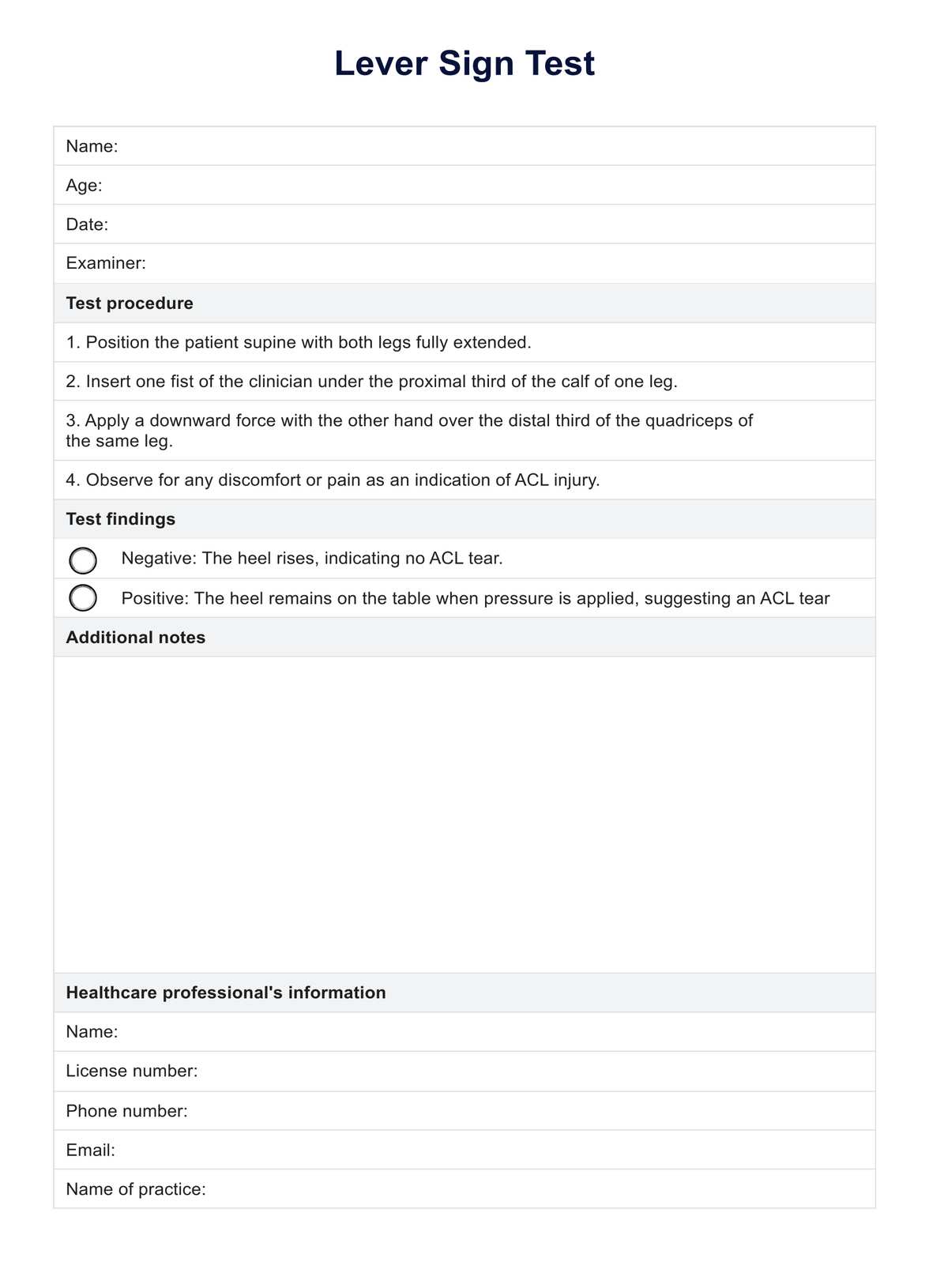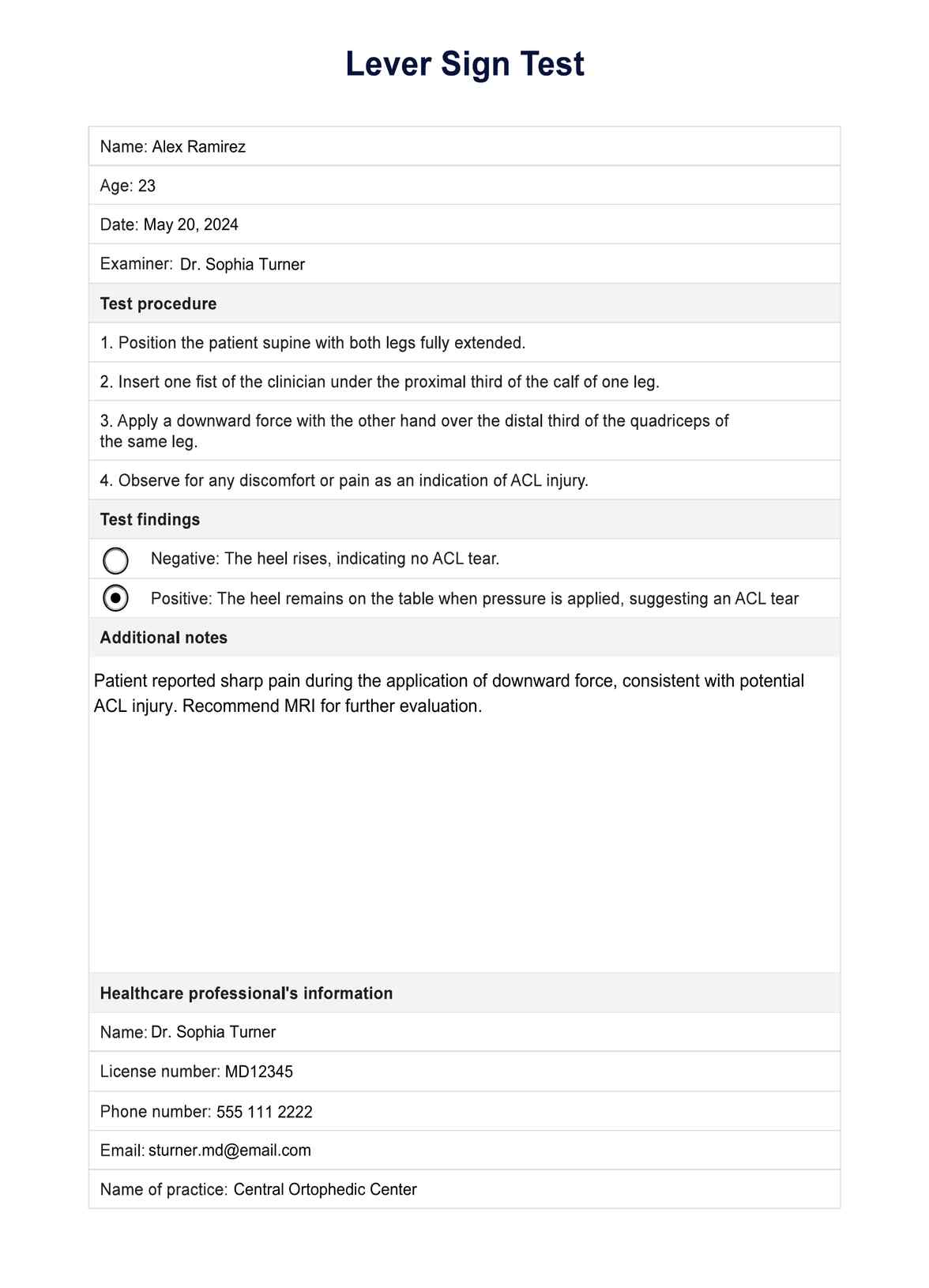Lever Sign Test
Discover the Lever Sign Test for ACL injury assessment. Learn how to conduct the test and interpret results with our comprehensive guide and free template.


What is an ACL injury?
The Anterior Cruciate Ligament (ACL) is one of the key ligaments that helps stabilize the knee joint. It connects the thighbone (femur) to the shinbone (tibia). An ACL injury is a tear or sprain of this crucial ligament.
ACL injuries often occur during activities that involve sudden stops and twists, improper landings, or direct collisions, which are all common in physical sports that require sudden stops and changes in direction like soccer, basketball, and skiing. As such, athletes and active individuals are most susceptible to ACL injuries due to the high demands placed on their knees.
Symptoms include a popping noise at the time of injury, severe pain, rapid swelling, and a feeling of looseness in the joint. Loss of range of motion and discomfort while walking are also common.
ACL injury grades
ACL injuries can range from mild (small tears/sprains) to severe (complete tears). The severity is often graded on a scale:
- Grade 1: Mild damage; the ligament is slightly stretched but still able to keep the knee joint stable.
- Grade 2: A partial tear of the ligament.
- Grade 3: A complete tear of the ligament; the ligament is split into two pieces, making the knee joint unstable.
How to diagnose an ACL injury
Diagnosing an ACL injury involves a combination of physical exams, patient history, and imaging tests like MRI. Apart from the Lever Sign Test, other clinical tests include:
- Lachman Test: This test checks for anterior translation (forward movement) of the tibia relative to the femur without complete knee extension. It's considered one of the most sensitive tests for ACL injuries.
- Pivot Shift Test: This maneuver assesses if there's a noticeable shift or "clunk" when the knee is moved from a bent to a straight position, which indicates ACL insufficiency. If you need a Pivot Shift Test template, we have one in our template library.
- Anterior Drawer Test: Similar to the Lachman Test, but performed with the knee bent at 90 degrees, this test also checks for excessive forward movement of the tibia. Our template library also has an Anterior Drawer Test ready to download.
In addition to physical exams, imaging like magnetic resonance imaging (MRI) and X-rays play a crucial role in ACL injury diagnosis.
Lever Sign Test Template
Lever Sign Test Example
What is the Lever Sign Test?
The Lever Sign Test, also known as the Lelli Test, is a clinical examination used to assess the integrity of the ACL in the knee. It is designed to detect ACL tears by leveraging the lower leg and observing the response of the knee joint. This test is praised for its simplicity and effectiveness, particularly because it does not require any specialized equipment and can be performed quickly in various settings, from clinics to field locations.
How to conduct the Lever Sign Test
The Lever Sign Test is straightforward and can be conducted efficiently, making it accessible even in less-equipped environments. Here’s how to perform it:
- Have the patient lie flat on their back with legs fully extended.
- Place one hand under the patient's calf near the knee while the other hand applies a downward force on the thigh just above the knee.
- Observe the movement of the lower leg; a positive Lever Sign is indicated if the heel does not lift off the examination table while pressing down, suggesting an ACL tear.
What are the possible results and interpretations?
The Lever Sign Test yields two possible outcomes:
- Negative: If the heel rises off the table, it indicates a negative Lever Sign Test, meaning no ACL tear.
- Positive: The heel remains on the table when pressure is applied, suggesting an ACL tear.
A positive Lever Sign Test typically implies significant damage to the ACL, warranting further diagnostic imaging like an MRI and consultation with a specialist for a comprehensive treatment plan.
How does our Lever Sign Test template work?
Our Lever Sign Test template is crafted to support healthcare professionals in efficiently documenting and interpreting the results of the Lever Sign Test. The template includes sections for patient information, detailed test procedures, findings, and additional notes, ensuring that all relevant details are systematically captured during the examination.
Step 1: Access this template
Healthcare professionals can easily access this template via the Carepatron app or on our website's template library. The template is available in digital format for easy entry and storage, or it can be printed for use in environments where digital devices are not practical.
Step 2: Explain the template
Before conducting the Lever Sign Test, healthcare professionals should explain the procedure outlined in the template to the patient. This ensures that the patient understands what to expect during the test and the significance of each step. Clarifying the process helps gain patient cooperation and ensures accurate results.
Step 3: Conduct the test using the template
Using the template, the healthcare professional follows the detailed procedural steps to conduct the Lever Sign Test. This includes positioning the patient, applying the correct forces to the leg, and observing the responses. Each observation and outcome should be recorded directly in the template to maintain a clear and organized record.
Step 4: Record the findings
After performing the test, the professional records the findings in the template. This section is crucial for noting whether the test result was negative or positive and includes space for any additional observations that may assist in further diagnosis or treatment planning.
Step 5: Discuss results and next steps
With the test complete and the findings documented, the healthcare professional should discuss the results with the patient and outline any necessary next steps. This might include referrals for further testing, starting treatment if an ACL injury is confirmed, or other recommendations based on the test results. Documenting this discussion in the template ensures a comprehensive record of patient care.
Benefits of using our template
Using our Lever Sign Test template offers several key benefits that can enhance the efficiency and accuracy of clinical assessments in various healthcare settings:
- Streamlined documentation: The template provides a structured format for recording all relevant test details, from patient information to test results. This standardization helps ensure that nothing is overlooked and makes it easier to review patient histories and track progress over time.
- Improved accuracy: By guiding the healthcare professional through each step of the test procedure, the template reduces the likelihood of errors. Accurate recording of test outcomes and observations is crucial for diagnosing and planning effective treatments.
- Enhanced communication: The template serves as a useful tool for communicating findings and recommendations to other healthcare providers. It can be easily shared and understood by different members of a patient's care team, ensuring that everyone is on the same page.
- Time efficiency: With pre-defined fields and clear instructions, the template speeds up the process of conducting tests and documenting results. This efficiency allows healthcare professionals to spend more time on patient care and less on administrative tasks.
- Patient engagement: Explaining the test and its findings using the template helps patients understand their condition and the steps involved in their diagnosis. This transparency can enhance patient trust and engagement in their treatment process.
These benefits demonstrate how our Lever Sign Test template not only supports healthcare professionals in their clinical duties but also contributes to a higher standard of patient care.
Treatment for an ACL injury
Effective treatment of an ACL injury is crucial for recovery and return to normal activities, especially for athletes and physically active individuals. Here are the primary treatment options:
- Rest and ice: Immediate care involves resting the affected leg and applying ice to reduce swelling and pain. Keeping the leg elevated and applying ice packs for 20 minutes every few hours can help manage initial symptoms.
- Medication: Pain relievers and anti-inflammatory drugs can be used to manage pain and reduce inflammation during the recovery process. It's important to use these under the guidance of a healthcare provider.
- Physical therapy: Essential for restoring strength and flexibility to the knee after acute ACL injuries. Therapists design specific exercise programs that gradually increase the knee's capacity to bear weight and move normally.
- Bracing: Patients may be advised to wear knee braces to stabilize the joint and prevent further injury during the healing process or while participating in physical activities.
- Surgical reconstruction: For complete tears or when stability is significantly compromised, surgical reconstruction of the ACL may be recommended. This involves replacing the torn ligament with a graft, usually from another tendon in the patient's body or from a donor.
These treatments, often used in combination, help to manage symptoms and facilitate recovery, allowing patients to resume their usual activities and sports gradually.
Commonly asked questions
The Lever Sign Test, also known as the Lelli Test, is a clinical examination used to assess the integrity of the anterior cruciate ligament (ACL) by observing the movement of the lower leg when pressure is applied to the thigh.
The Lever Sign Test is a clinical test specifically designed to diagnose injuries to the anterior cruciate ligament (ACL) by testing the knee's mechanical response to certain manipulations. It helps identify an intact ACL.
A 2017 study by Mulligan and colleagues at the Mayo Clinic found the Lever Sign Test had only 63% sensitivity and 90% specificity for detecting ACL injury.







































































































